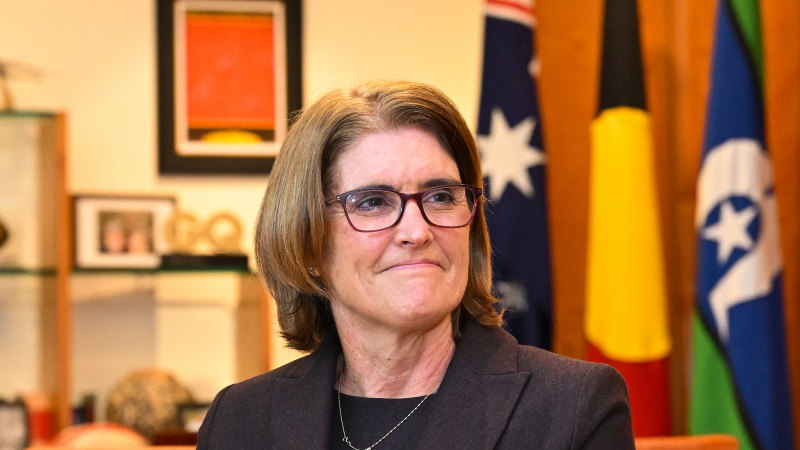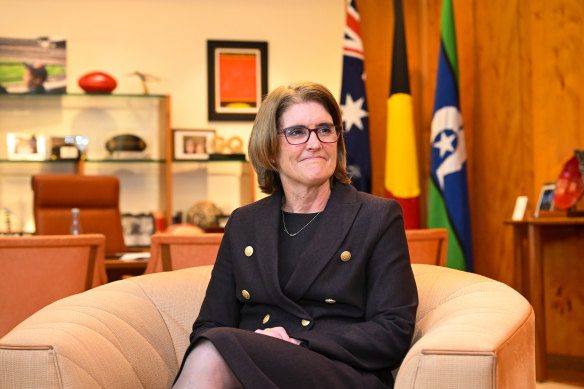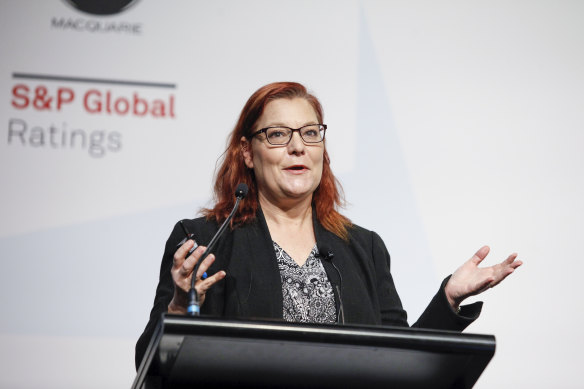New Reserve Bank captain sails into inflationary waters filled with icebergs

By Shane Wright
Save articles for later
Add articles to your saved list and come back to them any time.
Michele Bullock faces a situation that economist Nicki Hutley likens to the plight of Titanic captain Edward Smith.
Like most economists, Hutley expects Bullock and the Reserve Bank board to back a quarter of a percentage point increase in official interest rates when they meet on Melbourne Cup Day.
According to Hutley, Bullock is using monetary policy to guide Australia through an ocean filled with inflation icebergs that could strike an economy that has proven virtually unsinkable for the past three decades.
RBA governor Michele Bullock faces monetary policy icebergs.Credit: AAP
“It’s like being the captain of the Titanic. Once you’ve seen the iceberg, it’s too late,” she says.
Bullock, nearing the end of her seventh week in charge of the nation’s most important economic institution, faces her biggest test so far. It already has critics wondering if she will blink or risk the wrath of politicians, business owners and mortgagors by pushing up official interest rates.
Most economists and financial markets had been expecting the RBA’s next move on interest rates would be a cut, sometime next year. That narrative was turned on its head when the September-quarter consumer price index was released on October 25.
Across almost every measure of inflation, the figures confirmed prices were not coming down as quickly as expected.
Headline inflation lifted by 1.2 per cent in the quarter. The RBA’s preferred measure of underlying inflation, which seeks to exclude one-off price shocks, increased by the same amount.
While the annual rate eased to 5.4 per cent from 6 per cent, most commentators read the figures as confirmation the Reserve Bank’s hopes of a gradual decline in inflation had run aground on a shoal of price pressures encompassing everything from the cost of getting a haircut to the nation’s super-tight rental market.
And data on retail trade (up 0.9 per cent in September) and the jobs market (unemployment edged down to 3.6 per cent in September) suggests the economy is absorbing current interest rate settings without much trouble.
This week, the International Monetary Fund – which has spent the past fortnight in Australia talking to organisations such as the Reserve Bank and Treasury – said it believes interest rates have to go higher.
It also urged governments, particularly the states, to either delay or axe some of their infrastructure spending to take some heat out of the economy.
UNSW economics professor Richard Holden says the bank has to lift rates next week and consider more increases if inflation fails to come to heel.
He says based on the Reserve Bank’s own long-term forecasts, inflation will not return to the RBA’s 2-3 per cent target band until late 2025.
From December 2021 to December 2025, inflation will have climbed by almost 20 per cent. The last time inflation climbed so much over a four-year period was in the late 1980s.
Independent economist Nicki Hutley says guiding the Reserve Bank is akin to captaining the Titanic.Credit: Eamon Gallagher
Holden says not only is inflation hurting people by making everyday goods and services more expensive, it is also hitting those with savings.
“The $100 you saved in the bank is actually now worth $80. People are just not focused on what inflation does to their savings, but it’s happening,” he says.
“It’s not just people who are not borrowers being hit by inflation, it’s people with money as well.”
Many commentators have noted that Australia’s official cash rate – currently at 4.1 per cent – is much lower than those in comparable countries.
This week, the United States’ Federal Reserve held its key interest rate at 5.25-5.5 per cent. New Zealand’s cash rate is at 5.5 per cent, Canada is at 5 per cent while the Bank of England is at 5.25 per cent.
Holden says it would seem astounding that Australia is so different from its international peers that it could bring inflation down with a much lower cash rate.
“Is the Australian economy so special?” he asks.
One way Australia is different, and which the Reserve Bank has noted, is the way changes in official interest rates are quickly passed on to borrowers.
Americans, for instance, traditionally take out 30-year fixed-rate mortgages. The only home buyers in the US being hit with its ramp-up in interest rates are those just coming into the market.
But in Australia, millions of home buyers have endured a sharp increase in their mortgage repayments. On a $600,000 mortgage, monthly repayments have jumped by more than $1400 since May last year. Another quarter of a percentage point increase on Melbourne Cup Day would lift the monthly increase beyond $1500.
Collectively, home borrowers paid $15.4 billion in interest on their mortgages in the June quarter. A year earlier, they paid less than $8 billion.
Those higher interest payments leave less money for home buyers to spend on other goods and services. Spending on household goods, second only to food in terms of what Australians outlay cash on every month, has fallen by 4 per cent over the past year despite a surge in the number of people in the country.
The Reserve Bank is already awake to the deteriorating financial situation of some Australians.
In her first major speech as governor, Bullock noted about 5 per cent of all borrowers with a variable-rate mortgage are now spending more than they earn. This increases to about a quarter of all highly leveraged borrowers (those who have loans at least four times their income).
“These borrowers may be finding ways to make ends meet, but this can involve some difficult financial decisions. This could include drawing on past savings, working extra hours if they are able, or forgoing some expenditure that would in normal times be considered non-discretionary,” she noted.
Less spending flows through, usually, to a softer jobs market. The Reserve is expecting unemployment to lift to 4.5 per cent by the middle of 2025.
Hutley says while plenty of economists and investors are urging the Reserve Bank to lift interest rates, they are ignoring the human toll.
“The danger as a macroeconomist is thinking only in terms of 25 basis points as just a number. It means tens of thousands of people out of work,” she says.
“This is really going to hurt those people who are on the margins.”
Former Reserve Bank economist and now economics lecturer at Monash University, Zac Gross, says taking the cash rate to 4.35 per cent would confirm Bullock was maintaining the bank’s long-term commitment to fighting inflation.
“A quarter percentage is not going to make a huge difference, but it would show the bank’s serious about getting inflation under control,” he says.
But he says by not moving, the Reserve could easily make inflation worse.
Technically, one of the bank’s primary roles is to maintain the value of the currency. If the RBA holds interest rates steady, the Australian dollar would probably fall in value against the US dollar, the euro and the English pound.
A drop in the value of the dollar would flow through to consumers as the price of imported goods increased. The pass-through to oil prices would be felt almost immediately.
“If the dollar loses one cent in value, then that means a one cent a litre increase in the price of petrol,” Gross says.
At her sole public appearance since the release of the inflation figures, Bullock played her cards close on what the data would mean for the direction of interest rates.
“We don’t know if the job is done yet,” she told a Senate hearing in Canberra.
Holden believes Tuesday’s meeting looms as a defining point in Bullock’s nascent tenure running the Reserve Bank.
“My feeling is that this is going to be a huge test, a huge signal as to her commitment and the commitment of the board to getting inflation under control,” he says.
Cut through the noise of federal politics with news, views and expert analysis from Jacqueline Maley. Subscribers can sign up to our weekly Inside Politics newsletter here.
Most Viewed in Politics
Source: Read Full Article

